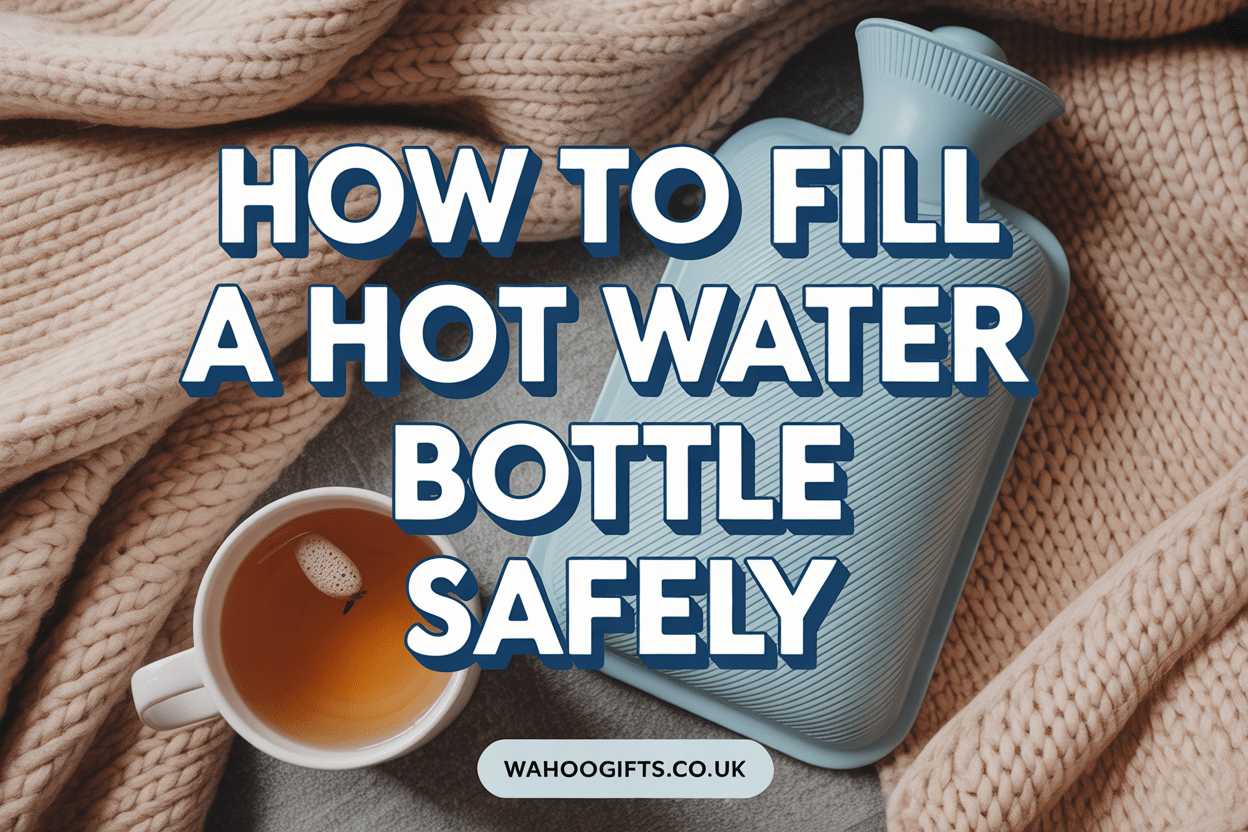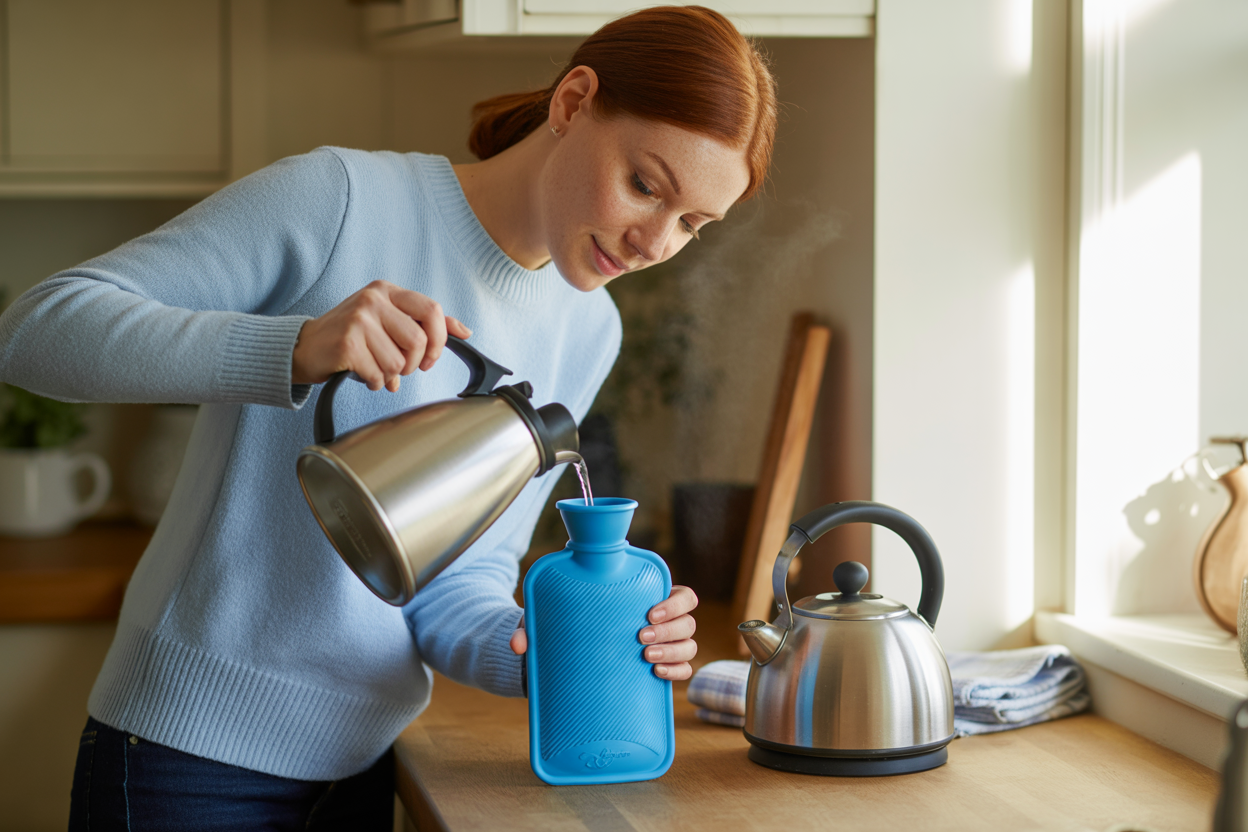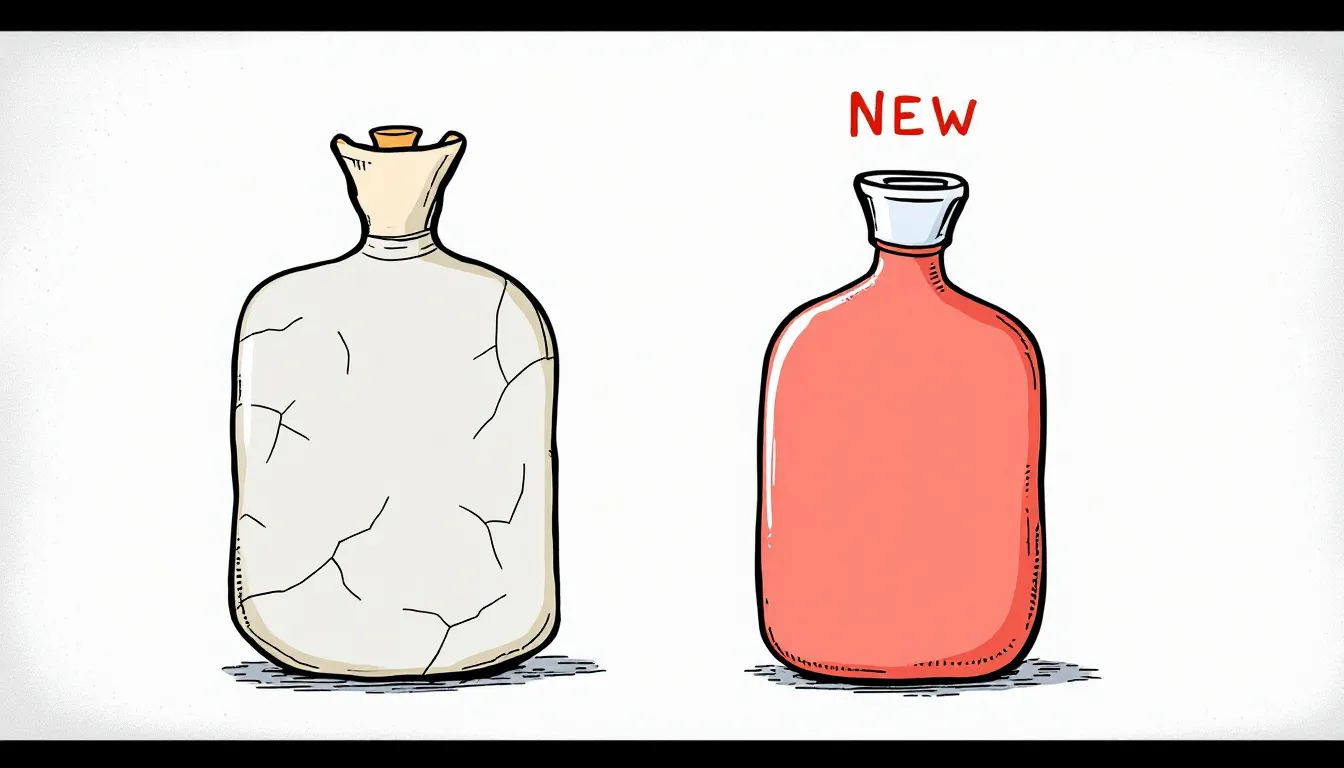
The Smart Way to Learn How to Fill a Hot Water Bottle Safely
A Complete Guide on How to Fill a Hot Water Bottle Safely
Looking to learn how to fill a hot water bottle safely? Follow these steps to do it right.
Key Takeaways
-
Hot water bottles provide various benefits, including pain relief, improved digestion, and enhanced sleep quality, while being energy-efficient alternatives for warmth.
-
To fill a hot water bottle safely, inspect it for damage, use water at a controlled temperature, and ensure proper positioning during the filling process to prevent spills and burns.
-
Regular maintenance, such as checking for leaks and replacing hot water bottles every two years, is essential to ensure safety and longevity.
Why Use a Hot Water Bottle?

Hot water bottles offer a variety of benefits, making them a versatile and valuable addition to your household. One of the primary advantages is their ability to provide pain relief. Benefits include:
-
Providing pain relief by applying heat to specific areas such as the abdomen or back, alleviating discomfort from menstrual cramps, pregnancy, and other muscle aches to ease aches.
-
Soothing warmth that stimulates digestion.
-
Reducing symptoms of bloating and cramps by enhancing circulation in the stomach area.
Hot water bottles are also excellent for keeping warm during colder months. They create a cozy environment in your bed or under a blanket, allowing you to stay warm while staying warm without relying on more energy-intensive options like central heating or an electric blanket. This environmentally friendly choice also saves on energy costs. The gentle heat from hot water bottles also improves sleep quality by promoting relaxation and reducing stress and anxiety.
They offer benefits for overall well-being by increasing blood flow, which contributes to healthier skin and a radiant glow. Whether dealing with an illness or just looking to enhance comfort and relaxation, a hot water bottle provides soothing general warmth and a sense of well-being for the body.
With so many benefits, hot water bottles remain a popular choice for many people.
Preparing to Fill Your Hot Water Bottle
Ensure your hot water bottle is in good condition and safe to use before filling it by following these steps:
-
Inspect the bottle for any signs of damage, such as cracks or wear, which could lead to leaks and potential burns.
-
Test the seal with cold water, especially if the bottle is new or hasn’t been used for a while.
-
Make sure your hot water bottle complies with safety standards to ensure safety.
After confirming the bottle’s condition, prepare the water by following these steps:
-
Allow the boiled water to cool for 15-20 minutes before filling the hot water bottle.
-
The ideal water temperature is around 50-60 degrees Celsius, as using overly hot water can damage the bottle and increase the risk of burns.
-
Ensure the water temperature does not exceed 42 degrees Celsius (100 degrees Fahrenheit) for safety.
Position the hot water bottle correctly before filling. Place the bottle on a flat, stable surface with the stopper removed. This avoids accidental spills and keeps the bottle stable during filling.
Following these steps will help you fill a hot water bottle safely and effectively. Start by listing some forbidden forms of the keyword “fill a hot.”
Filling a Hot Water Bottle Safely

Filling a hot water bottle safely involves a few critical steps to avoid any risks. Use the correct water temperature, position the bottle properly, and pour the water carefully.
These steps prevent injuries and ensure the hot water bottle remains effective and safe.
Boil and Cool the Water
Never use boiling water in a hot water bottle as it can damage the bottle and cause burns. Let the boiled water cool to a safe temperature before filling the bottle. This step prevents injuries and ensures the longevity of the hot water bottle.
The ideal water temperature is around 50-60 degrees Celsius, below boiling. Water at this lower temperature range avoids damaging the bottle and ensures safe use. Allowing the water to cool enables you to fill your hot water bottle safely and enjoy its warmth without risks.
Position the Bottle
Always place the bottle on a flat, stable surface with the stopper removed before filling. This:
-
Keeps the bottle stable
-
Reduces the risk of accidental spills
-
Avoid filling accidents
-
Ensures the bottle is filled correctly
Proper positioning maintains balance and prevents unnecessary movement during filling. Keeping it on a flat surface lets you sit and fill the hot water bottle safely and efficiently.
Carefully Pour in the Water
Pour water carefully into the hot water bottle until it is about two-thirds capacity, monitoring the water level. Avoid overfilling to reduce the risk of bursting. A funnel can help minimize spills and ensure accurate pouring.
Leave about 2 inches of space at the top to prevent overflow and ensure proper sealing. This ensures the hot water bottle remains safe and effective.
Removing Excess Air
To prepare the bottle:
-
Remove excess air to prevent leaks and ensure better heat distribution.
-
Lay the bottle horizontally on a flat surface until the water reaches the opening.
-
This expels any trapped air and maintains the bottle’s shape.
Expelling the air before sealing enhances heat retention and prevents injuries from escaping hot air, as excess pressure can lead to dangerous situations. Ensuring the air is removed allows you to use the hot water bottle safely and effectively.
Sealing and Checking for Leaks
Properly sealing the hot water bottle and checking for leaks ensure safety. Regularly inspect the bottle for any signs of wear, damage, or leaks. This helps prevent accidents and ensures the hot water bottle remains safe.
Secure the Stopper
Screw the stopper on tightly enough to prevent leakage, but finger tight is usually adequate. Turn one bottle upside down slowly after securing the stopper to check for leaks. This ensures the bottle is sealed properly and safe to use.
Tilt the bottle away from yourself over a sink to check for leaks. This detects any potential leaks and ensures the hot water bottle is ready for use without risk of accidents.
Inspect for Leaks
Inspecting for leaks ensures safety and prevents accidents during use. Tilt the bottle over a sink after securing the stopper to check for tap water leakage. This identifies any issues with the seal and ensures the bottle is safe to use.
Regular checks for cracks or leaks maintain the functionality and safety of the hot water bottle. Thoroughly inspecting the bottle prevents potential injuries and ensures it remains effective.
Using Your Hot Water Bottle

Wrap the hot water bottle in a cloth or towel to prevent burns caused by prolonged direct contact with your skin. This not only protects you but can also add a touch of personal style if you use a decorative cover. This prevents burns and adds a layer of personal style with a cover. Avoid using hot water bottles with electric blankets to reduce the risk of burn.
Do not allow babies to use hot water bottles due to the risk of burns. Avoid prolonged direct contact with the hot water bottle as a cushion or sitting on it to reduce the risk of leaks or bursts, especially if it is made of rubber.
Following these safety tips ensures you use your hot water bottle safely and effectively.
Proper Storage and Maintenance
Proper storage and maintenance ensure the longevity and safety of your hot water bottle. Follow these steps:
-
Store the hot water bottle in a cool, dry place away from sunlight.
-
Empty any remaining water after use.
-
Let the hot water bottle air dry completely.
-
Hang the bottle upside down to ensure it dries thoroughly.
Avoid placing heavy objects on top of the hot water bottle to protect its structure during storage. Keep the hot water bottle away from heat sources like radiators to maintain its integrity and prolong its lifespan.
When to Replace Your Hot Water Bottle

Hot water bottles typically have a lifespan of around two years, after which the risk of damage increases. Regularly inspect your hot water bottle for signs of wear and tear like visible cracks, leaks, or a worn texture to ensure safety. Using an older hot water bottle increases the chance of cracking or leaking, leading to burns or injuries.
Discard any hot water bottles that are damaged or expired. This helps you avoid potential accidents. Replacing your hot water bottle when necessary ensures continued safe enjoyment of its benefits.
Summary
In summary, hot water bottles offer numerous benefits, from pain relief and warmth to environmental friendliness. Ensuring safety when using a hot water bottle involves proper preparation, filling, sealing, and regular inspections. By following the guidelines provided, you can enjoy the comfort and warmth of a hot water bottle safely and effectively.
Remember to replace your hot water bottle when it shows signs of wear or reaches the end of its lifespan. By doing so, you can continue to experience the soothing benefits without any risks. Stay warm, stay safe, and make the most of your hot water bottle.
Frequently Asked Questions
How often should I inspect my hot water bottle for damage?
You should inspect your hot water bottle for damage before each use to ensure it is safe and free from wear, cracks, or leaks. Regular checks are essential for your safety.
Can I use boiling water in my hot water bottle?
Boiling water should not be used in a hot water bottle, as it can damage the bottle and pose a risk of burns. Opt for hot, but not boiling, water to ensure safety and longevity of the bottle.
What should I do if my hot water bottle leaks?
If your hot water bottle leaks, you should stop using it right away and purchase a new one to avoid the risk of burns and injuries.
How should I store my hot water bottle when not in use?
To maintain the integrity of your hot water bottle, store it in a cool, dry place away from direct sunlight and heat sources. This will help prolong its lifespan.
Can I use a hot water bottle in conjunction with an electric blanket?
It is not safe to use a hot water bottle in conjunction with an electric blanket, as this combination poses a risk of burns and overheating. Prioritizing safety is essential when using heating devices.





